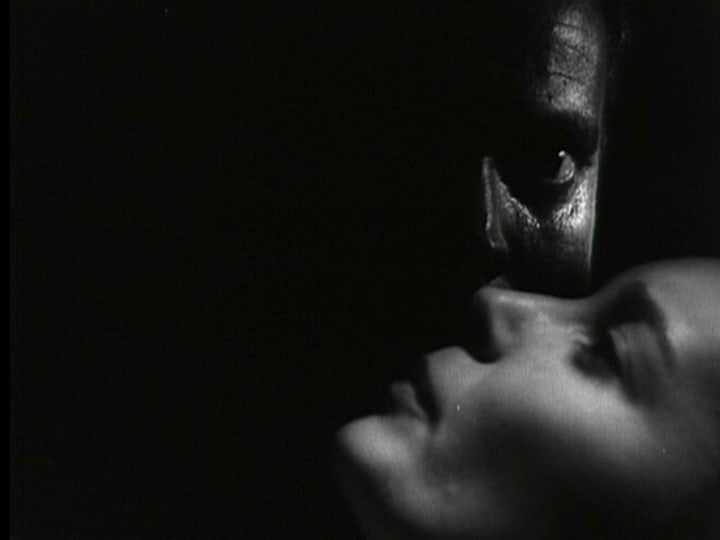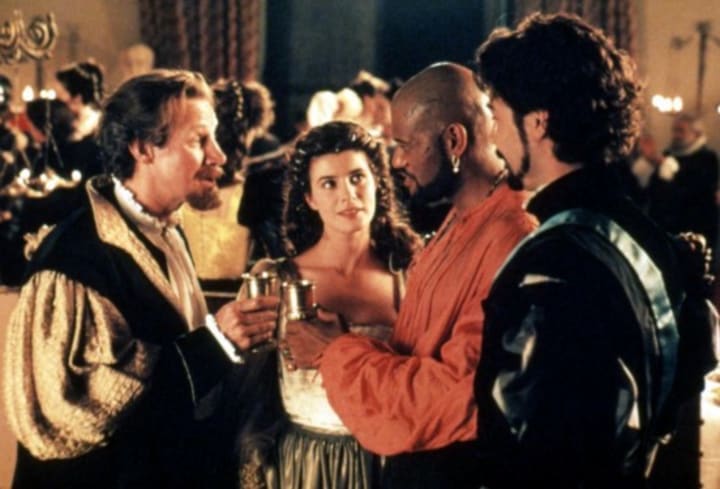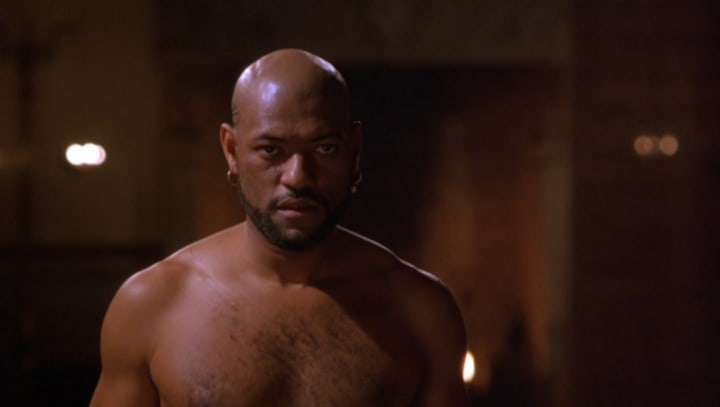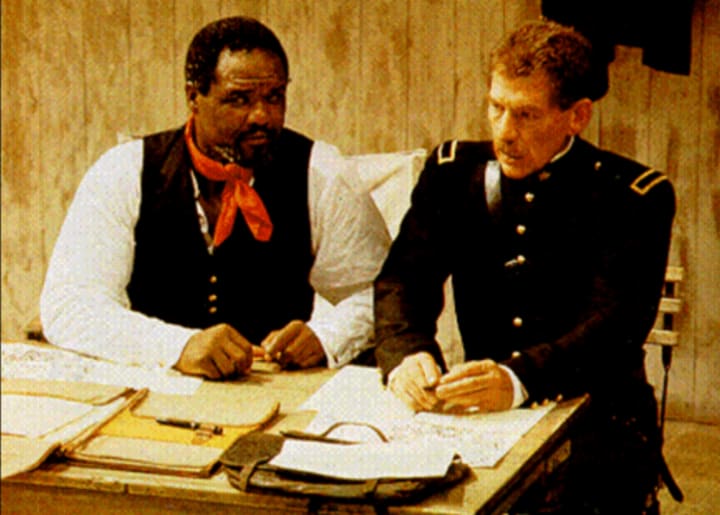The Moor of Hollywood
An analysis of Oliver Parker's Othello

Writer and debutant director Oliver Parker’s 1995 film adaptation of Shakespeare’s Othello is a landmark in the long, extensive performance history of the play. One of a stream of the ‘New Wave’ Shakespeare films that followed in the wake of Kenneth Branagh’s Henry V (1989), Parker’s film succeeds over twenty recorded screen adaptations for film and television but represents the first time that Shakespeare’s great tragedy received a commercial, mass-market treatment for the Hollywood market.
Despite its prominence within the Shakespeare canon, a mainstream cinematic release had eluded Othello prior to 1995. Arguably the two best-known screen adaptations, prior to Parker’s film, were Orson Welles’ expressionist 1952 production and and Stuart Burge’s conventional 1965 filming of John Dexter’s National Theatre production, infamous for a fully “blacked-up” Laurence Olivier in the lead.
Parker’s belated Hollywood version is an experience that is both liberating and restrictive in translating the story to the screen. As is virtually custom with screen Shakespeare, the text is largely cut; Parker’s Othello runs at two hours, with essentially an hour of textual material extracted. Parker greatly cuts the length of certain scenes, an example being the removal of the playful banter between Iago, Desdemona and Emilia upon their arrival in Cyprus, with the action cutting straight to Othello’s victorious entrance. Critics and pursuits were disappointed with the “dumbing-down” and “subsitution” of Shakespeare’s poetry for added inclusions of sex and nudity:
‘Filmmaker Parker, whose screenplay strips down the original play, merely produces a lackluster essence. What remains is to savor the passing beauty of Shakespeare, no matter who utters it’’. (1)
Such textual alterations, and controversial inclusions, might prompt one to question the purpose in adaptating Shakespeare for the commercial Hollywood market. When later working on his own 1996 production of Hamlet, Kenneth Branagh (cast as Iago in Parker’s film) voiced an interesting incentive for the production of Hollywood Shakespeare:
“I don’t think that Hollywood sees Shakespeare films as blockbusters; but in the end, they must make their money back. It is not a sure-fire investment; but they do have a long shelf-life. It is a multi-generational product that embraces education, and with the video revenues included, it can be pretty lucrative”. (2)
Parker’s Othello was not a blockbuster; it was a financial flop. Filmed for approximately $11 million, the film recouped just over $2 million in the United States, under half of its budget. Parker himself, speaking in a 1995 edition of Vanity Fair, outlined his intentions for the film:
“Hopefully the whole thing will be a mixture of classical and contemporary. The key intention was to turn it into as much of a film as possible, and as little of theatre”. (3)
Parker’s aim to provide viewers with an essentially cinematic rendering of Othello provides us with something of a pathway in approaching the film. Professor Russell Jackson has observed that Shakespeare films are essentially melting points of the critical, performance and public histories of the plays:
“Films made from Shakespeare’s plays exist at a meeting-point between conflicting cultural assumptions, rival theories and practices of performance, and ,at the most basic level, the uneasy and overlapping systems of theatre and cinema”. (4)
Theatrical, Filmic and Realist Approaches

Jack Jorgens has distinguished between three types of Shakespeare film –those grounded in the theatrical mode and others in the filmic mode, with realist films falling between the two (5). Interestingly, there has been a screen version of Othello for each of the three categories. Theatrical films aim to effectively translate theatrical performance onto the screen, such as Burge’s filming of Dexter’s production, making little, if any, cuts to the text and usually are devoid of structural alterations to the play. Filmic adpatations are distinctively more cinematic, often using “non-theatrical techniques a great variety of angles and distances, camera movement” with direction that “substitutes for the classical style of playing on the lines, the modern style of playing between the lines”. Consequently, such productions bring ‘intentional emphasis on the artifice of film, on the expressive possibilities of distorting the surfaces of reality”(6). Welles’ Othello is a quintessential example of filmic Shakespeare, its dramatic effect coming not so much from Shakespeare’s language but rather from Welles’ constant stream of striking visual compositions, which heighten in intensity as Othello’s feverish jealousy and madness increases.

Finally, Jorgens identifies the realistic mode as where the majority of Shakespeare films come under. James N. Loehlin describes such films as “characterized by the sort of mid-range naturalistic acting, cinematography and editing that is used in most Hollywood films. The characters are represented as real people, in plausible make-up and costumes, and the film relates the narrative straight-forwardly without calling attention to the medium”(7).
Generally, Parker’s Othello is a realistic Shakespeare film. Critical response has often compared it unfavourably with Welles’ boldly more cinematic vision, feeling that Parker ultimately produced a film lacking in filmic innovation and more grounded in the realistic mode than he originally intended. Sight and Sound reviewer Geoffrey Macnab underlined that Parker’s film, in contrast to Welles, vitally lacked “visual flair”, stressing that whilst the director “clearly has a strong sense of the play as a violent, noirish melodrama…he hasn’t rendered it in cinematic terms”(8).

Although such criticism undermines the director’s own claim to make his Othello a principally cinematic experience, Parker’s film is not without its distinctions, with some of his best work being particularly visible in his dramatisation of Act III, Scene III. In the clearest structural change to the text, Parker dissects the lengthy, central ‘temptation’ scene and shoots it over the course of a day, in accordance with the action time of the story. Beginning with a playful, day-time stick-joust between Othello and Iago (easily won by the latter, in contrast to the psychological battle that follows), Parker moves the pair’s conversation to an arsenal chamber, filled with an assortment of various rifles and weapons, as Iago’s lies come into play. Parker visually realises Iago’s desire to fill Othello’s “ear with pestilence” with a shot of Iago whispering into Othello’s ears as he begins to envision Desdemona flirting with Cassio. Parker then cuts to Iago dressing the increasingly weary Othello, in his best evening-wear, as the latter begins to sway to Iago’s deceptions. One of Parker’s clearest additions to the text then follows as Othello suffers a slight seizure, a pre-cursor to his later bout of epilepsy, as images of Desdemona’s infidelity begin to plague his mind, whilst Iago is shown looking on the scene from the doorway, out of Othello’s sight.
“I am not what I am” — Iago as Director

If Parker’s approach is largely conventional, the director at least demonstrates a degree of reflexivity in acknowledging his Othello as a filmic text through his handling of Iago, as portayed Branagh. Branagh, who makes the switch from Shakespearian hero (having previously won audiences with portrayals of Henry V, Benedick and, soon after Othello, Hamlet) to Shakespearian villain, delivers an Iago who is soft-spoken, charming and outwardly warm, a contrast to more forthright portrayals of the villain on-screen; Michael MacLiammoir, in Welles’ film, was visibly menacing in the role, Frank Finlay icy and devious alongside Laurence Olivier’s Othello and Bob Hoskins a giggling, sadistic devil in the BBC’s Othello for The Complete Dramatic Works of William Shakespeare series.
In a review for Shakespeare Bulletin, Robert Wilson acknowledges that Parker grants considerably larger emphasis and focus on Iago over Othello (9). In foregrounding Iago, Parker’s approach falls in line with the trend of the late Victorian era. Iago is, of course, substantially centred in Shakespeare’s text through his soliloquies to the audience and the simple fact that he has more lines than Othello. Parker expands the character further by making him very much a voyeur in the film, empowered with the privilege of looking, and assigning him almost a quasi-directorial status, situating him behind doors, looking onto a scene or hidden somewhere within it. For example, in the scene where Desdemona is unable to present the handkerchief to her husband, Parker shows us as Othello exits the bedchamber, opening the doors to reveal Iago standing behind them, presumably having done so all along.
Such an apt moment suggests a reading of Iago as a director, behind-the-scenes, back-stage, whilst his own play is enacted on the stage. The fact that Othello does not react at all to Iago’s presence underlines the idea even further, the latter taking on an authorative, almost omnipresent stance throughout the action. Judith Bunchnan makes in-depth reading of the emphasis given to Iago’s directorial-like role, citing Iago as the film’s “internal cinematographer” who explicitly instructs the spectator to look, and indeed how to ‘look, at Othello, who determines how Othello should look both at others and at himself”(10).
Parker himself further emphasises his positioning of Iago as a directorial figure within the film in his filming of Act IV, Scene II. The deeper Iago penetrates Othello’s mind, the deeper and more forcefully darker the setting and mise-en-scene becomes. In an underground dungeon / torture chamber, Othello’s bout of epilepsy is stimulated by an explicit vision of Cassio and Desdemona having sex. Emerging from his fit, he delivers the line “Did he confess it?” directly to the camera. Iago also looks at the camera, momentarily horrified, as if expecting Othello to hear the audience’s screams of denial, the first time in the film that his director-like power appears out of his control. Such moments arguably testify that this Othello, whilst broadly conventional and realistic, to use Jorgens’ terms, is, to some extent, self-aware in its stance as a filmic Shakespeare text.
There also numerous allusions to other film versions of Othello, in particular the Welles’ version. The 1952 film tends to dominate critical reaction to Parker’s film, though frequent contrast, and is seemingly intentionally echoed through various aspects of its structure and mise-en-scene. In both films, there is an early sequence (independent of Shakespeare’s play) showing the secret marriage of Othello and Desdemona, although one can understand this more as an audience-friendly introduction to the plot, as the play randomly begins in the middle of a conversation between Iago and Roderigo. Later, when Iago observes the reflection of Cassio and Desdemona in his knife, Parker is directly referencing a moment in Sergei Yutkevich’s 1955 Soviet production. When Othello cries to Iago for “a living reason that she’s disloyal” on the coast by the sea, the director echoes the the similarly shot confrontation between Welles and MacLiammoir, whilst Othello’s later call to “arise, black vengeance”, atop a castle tower, again parallels a scene from the Welles film.
However, the most striking reference and reworking of Welles occurs during Parker’s shooting of Act 4, Scene 1 where, having awoken from his seizure, Othello is urged by Iago to hide in a cage in order to overhear Cassio, mistaking his boasts over Bianca as evidence for his affair with Desdemona. Deploying the cage motif which ran through the earlier film, expressively visualising the ill-fated character’s entrapment and isolation, Parker evokes greater significance, within the context of his film, by the fact that his Othello is played by an African-American. Thus, whilst making the link to Welles, Parker simultaneously gives the scene a disturbing new twist by drawing attention to the historical issue of slavery. For all his success as a soldier and achievements as black man, Othello, unwittingly and unknowingly, is reduced to a slave in Parker’s film, not just symbolically through Iago’s victory in psychological warfare, but also visually, to the attention and awareness of the audience.
Othello and O.J

The production of Parker’s Othello was surrounded by the immense media hype and public fascination surrounding the murder trial of O.J Simpson, which became virtually synomous with the production due to the parallels between real-life and Shakespeare’s play. Indeed, Lisa S. Starks has pointed out how Parker’s film in particular is constructed around numerous cultural intertexts, with the media frenzy surrounding the Simpson case most prominent above all:
“As a film released in postmodern America, Parker’s Othello is tied even more closely to peripheral mass culture than film versions preceding it…Parker’s Othello was framed by the Simpson trial and its cultural debris, which figured significantly in the film’s reception by both critics and general audiences”. (11)
Like Othello, Simpson was a successful black man, a sporting hero turned popular actor. Yet, when charged with the murder of his wife, a white woman, Simpson “came to embody the stereotype of the lustful, dangerous black man in the media” (12). When asked on-set whether he had the Simpson case in mind while filming, Parker replied: “Everyone’s got it in mind, impossible not to. There are uncanny parallels in the events, but here we know Othello did it” (13).
In the casting of Laurence Fishburne, Parker’s Othello marks the first time that an African-American portrayed the role in a commercial cinema production, a revealing fact despite the numerable film and television adaptations throughout the twentieth century. G.K Hunter noted the bias and revealingly contrasted such prejudice against the original intentions of Shakespeare who, with the character of Othello, “produced a daring theatrical novelty — a black hero for a white community — a novelty which remains too daring for recent theatrical audiences” (14). It is telling that Hunter sees the seventeenth century concept of a black hero just as ‘daring’ for audiences of the twentieth century. Hunter reads that Othello’s blackness “has a theatrical purpose… it is obvious that he counted on some positive audience reaction to this colour; but it is equally obvious that he did not wish the audience to dismiss Othello as a stereotype nigger”(15).
More recently, Kim Newman acknowledges the “racist, sexist and colonialist” climate of the early modern period but, nevertheless, perceives Othello as ground-breaking for Shakespeare’s considerable attention to a black hero: “Othello is, of course, the play’s hero only within the terms of a white, elitist male ethos, and he suffers the generic “punishment” of tragedy, but he is nevertheless represented as a heroic and tragic at a historical moment when the only role played by blacks on stage was that of a villain of low status” (16). Five years before Fishburne, opera tenor Willard White acheived the distinction of being the first black actor to be recorded on-screen playing Othello in Trevor Nunn’s RSC stage-to-screen production for television, a performance which arguably signalled that it was time for a black actor to make his mark in a movie version of Othello.

Like the film itself, Fishburne’s performance received a mixed response. A.J Walker, writing in The Evening Standard, saw Fishburne as miscast, not so much in terms of performance but, rather bizarrely, for his blackness. “Fishburne’s blackness, in terms of Shakespeare’s play, is the wrong shade. It is ghetto blackness. It is associated with Hollywood’s “blax-ploitation” factory, not the Doge of Venice’s military hierarchy…Fishburne’s Othello is the first Othello who actually looks shiftier than Iago” (17).
Walker’s potentially controversial assessment could not have been further from that of Branagh who commended Fishburne as “the most wonderfully complete Othello” for his “depth of feeling, intelligence…He has natural grace, but he’s not afraid to be savage”(18). In casting Fishburne, Parker himself said that he “wanted a younger Othello than is normally played, somebody with a mixture of danger and sexuality…to give it a sense of vigor and youthfulness”(19), somewhat in line with the intentions of Jon de Simio, senior vice president of publicity and promotions of Castle Rock, to ensure that the film would not be “stuffy” but rather “a young, virile and passionate story”(20).
The casting of Fishburne was also partially intertextual since he had recently played the abusive husband in the 1993 Tina Turner biopic What’s Love Got to Do with It? thus playing with the actor’s familarity with audiences. On a similar note, Irene Jacob had also recently portrayed a role akin to Desdemona in Krzysztof Kieslowski’s 1994 film, Three Colours: Red. In a 1996 article in Premeire, Fishburne offered his own reading of Othello’s descent into jealousy and hysteria:
“The way I play these moments, when he’s in those fits of jealousy, is to make, is to make the connection that here’s a man whose life experience has been in battle. This man kills people for a living. It’s business. He’s never been in love before. He has given his heart to this woman, and then somebody tells him she’s running around — with his boy. Well, as a warrior, in his code of honor, Cassio has to die. And Desdemona has to die”. (21)
Fishburne’s assessment of Othello’s suspecibility to Iago’s devilish deceptions and subsequent actions as “business” comes across surprisingly simplistic when one considers the amount of debate over interpretation done by actors and critics since the play’s first appearance on the Jacobean stage. Coleridge, for example, understood Othello’s plight as a result of the crucial tainting of his psychological dependence on Desdemona, that “the creature, whom he believed angelic…should be proved impure and worthless…It was the struggle not to love her” although he did take into account the matter of Othello’s honour, adding that “Iago would not have succeeded but by hinting that his honour was compromised” (22).
In contrast to previous Othello’s of the screen, Fishburne is notably more subtle, retaining his outward civility and poise, even after he has committed himself to accepting Iago’s lies. One might compare his performance to the overwrought hysteria of Anthony Hopkins, over a decade earlier, in Jonathan Miller’s controversial 1981 BBC production. African-American actor James Earl Jones, who had played the role to great acclaim on Broadway, was the original choice but was bypassed in favour of Hopkins due to the director’s concern that the casting of Jones would cause the audience to think that the play was exclusively about blackness.
Various stage productions, since the exprementative decade of the 197Os have put some interesting variations on the racial issue of the play. For example, Charles Marowitz’s An Othello [1972] made both Othello and Iago black. More recently, in 1997, was Jude Kelly’s production for the Washington Shakespeare Theatre which had a white Othello in the form of Patrick Stewart with all the other characters being played by black actors. In having a black man on-screen playing the character, Parker works with the spectacle of intimacy between a black man and a white woman, a troubling aspect for many for much of its stage history. Virginia Mason Vaughan notes that the 1930 and 1943 productions of Othello starring Paul Robeson were “haunted by fear of public reaction to an openly sexual relationship between a black man and a white woman”(23), demonstrated in the fact that audiences were reportedly shocked when Othello and Desdemona kissed.
Shakespeare meets Fatal Attraction

Within the film, the historical tension between the interracial relationship is alluded to by Parker when Othello and Desdemona publicly embrace upon the former’s arrival in Cyprus, much to the visible embarrassment and discomfort of white on-lookers who are left in silence. However, naturally due to changes in censorship and racial attitudes, Parker’s film truly does break the mould for a production of Othello in that Othello and Desdemona are shown having sex on their first night together, following the feasting and celebrations in Cyprus. Unsurprisingly, this has been controversial in other ways for some, modernising and eroticizing the play and the relationship between Othello and Desdemona in order to cater to modern trends and audiences.
Yet, to simplistically criticise such a scene as exploitative and gratuitous is limiting to the interpretations and implications that are possible in the light of Parker’s film. For one, the scene directly works against the traditional reading of the marriage as unconsummated. Parker, be it through artistic choice or commercial pressure, pursues an alternative direction. It can be said that for the first time in the play’s performance history, Parker literally takes us inside the head of Othello. Indeed, Buchnan points out that whilst Othello is, in comparison to Shakespeare’s other tragic heroes, “least intimate with an audience, Parker allows the spectator an unusual degree of intimacy with Othello, both through occasional voice-overs and by subjectivizing his perceptions”(24).
In Parker’s film, Othello and Desdemona’s act of sexual intercourse is at the heart of Othello’s descent into jealousy and vengeance. As Iago’s lies begin to form in his mind, Othello envisions Desdemona’s infidelity with Cassio, which takes place in their own bed. One revealing shot is an exact repeat of an earlier one, where Othello’s black hand reaches and grasps Desdemona’s white hand, as the pair reach orgasm. Parker reworks this by substituting Othello’s hand for Cassio’s white hand, making the difference decidedly notable to the viewer. Othello’s imaginings increase in explicitness, climaxing with Cassio and Desdemona naked in bed in intercourse, which Parker shrewdly films as a montage. Here, the camera cuts increasingly faster as the erotic images rapidly heighten, suggesting the fragmentation of Othello’s mind, which has been overpowered by Iago’s suggestive imagery, and his self-refusal or inability to wholly depict and perceive Cassio and Desdemona in the act of sex. Detractors may deem such a sequence as purely sexual gratification for the audience when, in fact, it serves as a visual apparatus for identification with Othello, whilst conflictingly demonizing Desdemona. One could conclude that Parker’s montage, particularly in such shots showing Cassio’s white body in place of Othello’s black body, underlines a deep fear in Othello that it his sexual performance that has been usurped by Cassio, rather just the object of affection that is his wife.

Yet, whilst the viewer is granted exceptional point-of-view from Othello’s perspective, the character is also made very much a subject in Parker’s film. Bunchan writes that “Othello’s body is…fetishized as a point of fascination by the intradiegetic attentiveness…of both Desdemona and Iago…in tune with the self-indulgent dictates of Othello’s own mind, it is also treated as an object of fascination and awe by the camera”(25). Buchnan makes the observation that in the scene where Othello and Desdemona undress for sex, it is Othello’s“undressing, not hers, upon which the camera lingers with the most intimate and detailed appreciation”(26).
Some have seen such a visual strategy surrounding Fishburne’s Othello as underlining of the film’s implied racist connotations. Deborah Cartnell, for one, argues that Parker “inserts images to underline the racist themes in the play, images which perhaps pander to his audience’s obsession with race”(27). Bunchan sees this as particularly evident in the film’s marketing campaign which Castle Rock’s Liz Halford orchestrated in order to “attract people who would not usually go to see a Shakespeare film”(28), modifying the film’s US poster from a noirish image of a glaring, menacing Fishburne to the more commercial image of Othello and Desdemona in a passionate act for the UK market. Such promotion emphasised the film as an erotic thriller, more in the style of Fatal Attraction (as noted by critics) than to a play of Shakespeare. Finally, Bunchan sees that:
“Parker’s film certainly plays to the same primal prejudices about the black man and black male sexuality that the O.J affair drew to the surface of white American society…Parker exploited some of the disturbing eroticism lurking in the deep-rooted white prejudice about the danger that it attaches to black male sexuality”. (29)
Othello is ultimately a play which demands constant revisiting in theatre, television and film and perhaps, more than any other of Shakespeare’s works, will be a text of constantly involving interpretations so long as discourse on race and representation is a hot topic. Parker’s Othello, through its various modifications for the screen, was never going to be the definitive production of Shakespeare’s play or one of the more enduring Shakespeare films. Nonetheless, it is a production that does have its merits and, from a historical and analytical perspective, is a significant entry in the play’s performance history.
References
1) Howe, Desson; Washington Post, December 29, 1995
2) Screen International, n.1049.15 Mar 1996, p.12–16
3) Screen International, n.1049.15 Mar 1196, p.12–16
4) Jackson, R. The Cambridge Companion to Shakespeare on Film, p.8
5) Jorgens J. Shakespeare on Film, p.18–9
6) Jorgens, J. Shakespeare on Film, p.20
7) Boose, E. Lynda & Richard Burt, Shakespeare the Movie, p.67
8) Sight and Sound, v6, n2, February 1996, p51–52
9) Shakespeare Bulletin, v20, n3. Summer 2002, p37–39
10) Bunchan, Judith, Shakespeare, Film & Film de Secile, p.186
11) Starks, Lisa S. “The Veiled [Hot] Bed of Race and Desire”, Post Script, p.64–78
12) Starks, Lisa. “The Veiled [Hot] Bed of Race and Desire”, Post Script, p.64–78
13) Independent on Sunday, January 1996
14) Hunter, G.K “Othello and Colour Prejudice”, p.31–59
15) Hunter, G.K “Othello and Colour Prejudice”, p.31–59
16) Newman, K. “And wash the Ethiop white”: Feminity and the Monstrous in Othello”, p151–3
17) A.J Walker, review from Evening Standard, referenced from Cartnell, D. Interpreting Shakespeare on Screen, p.77
18) Vanity Fair, n424. December 1995, p76–81
19) Vanity Fair, n424. December 1995, p.76–81
20) Screen International, n.1049.15 Mar 1996, p.12–16
21) Premiere, v9, n5. January 1996, p.52–53
22) Coleridge's Shakespeare Criticism, ed. Thomas Middleton Raysor, 2 vols. (London: Constable, 1930): Vol. I,pp.49,125; Vol II, pp.350-1
23) Potter, L. Othello: Shakespeare in Performance
24) Virginia Mason Vaughan, Othello: A Contextual History, p.181–2
25) Bunchan, J. Shakespeare, Film & Fin de Secile
26) Bunchan, J. Shakespeare, Film & Fin de Secile
27) Cartnell, D. Interpreting Shakespeare on Screen, p76/7
28) Screen International, n.1049.15 Mar 1996, p.12–16
29) Bunchan, J. Shakespeare, Film & Fin de Secile
About the Creator
Lawrence Bennie
History teacher & Theatre tour guide. Interested in Arts & Culture, Film, History, Psychology, and the odd mystery!






Comments
There are no comments for this story
Be the first to respond and start the conversation.